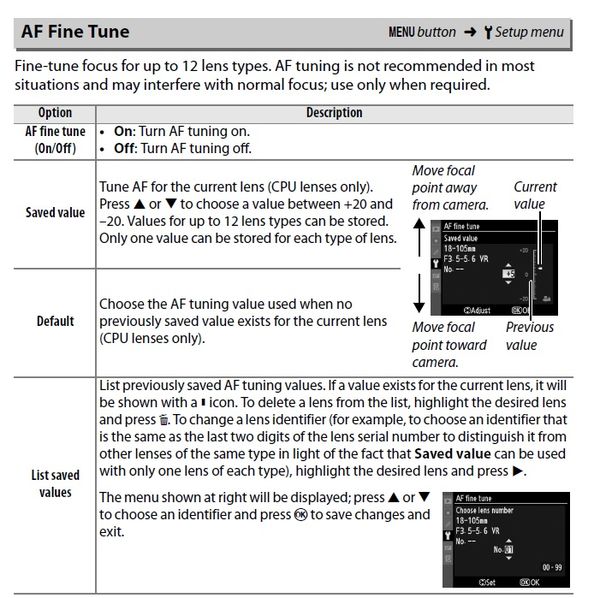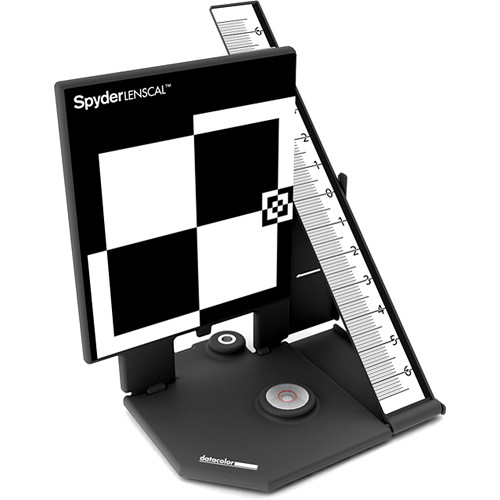"Fine Tuning" lenses
May 11, 2017 14:02:22 #
Dan Mc
Loc: NM
I am unfamiliar with this concept. Can someone please explain the procedures for this fine tuning? (Thanks in advance)
May 11, 2017 15:14:28 #
May 11, 2017 15:20:59 #
Some lens you can tune them for your camera to there most efficient focusing with that camera , some new ones come with a Turner
For $65 or more , Sigma is one that comes to mind , some camera stores will do it for a price ,
For $65 or more , Sigma is one that comes to mind , some camera stores will do it for a price ,
May 11, 2017 17:11:46 #
When using the viewfinder, your camera is using its phase detection autofocus. Phase detection autofocus is error prone. The AF sensors in the camera body must be very precisely aligned. Also, due to manufacturing tolerances, you can have camera and lens combinations that will front focus or back focus. I use the DataColor SpyderLensCal to calibrate mine. Many people use Reikan FoCal 2 software.
When your camera is in live view mode, it's using its contrast detection autofocus. There are no errors when using contrast detection autofocus. The camera adjusts the focus until it achieves the highest contrast at the sensor.
When your camera is in live view mode, it's using its contrast detection autofocus. There are no errors when using contrast detection autofocus. The camera adjusts the focus until it achieves the highest contrast at the sensor.
May 11, 2017 19:11:55 #
CO wrote:
When using the viewfinder, your camera is using it... (show quote)
Good comprehensive response.
May 11, 2017 19:58:18 #
CO wrote:
When using the viewfinder, your camera is using it... (show quote)
The first line in your screen shot from the manual says it all - AF tuning is not recommended in most situations and may interfere with normal focus; use only when required."
Phase Detection involves correct mirror alignment (two different mirrors). The AF sensor position is not adjustable, at least in the D800. Not sure about other cameras. However, the calibration software can write focus point values in a manner similar to AF Tune, but it does a broad range of focus points, and in the case of a zoom, at different focal lengths. Using the very coarse, single or dual point adjustment of AF Tune in the camera is not going to fix a front or rear focusing lens, without adversely affecting other focus points. If you are in the field, and you drop your camera but not enough to break it, but the focus seems off, yes, AF Tune is a good idea, as long as you bring it to the manufacturer's repair facility so they can assess, repair and adjust the system correctly and completely.
Here is a good explanation with pictures and diagrams that should help.
https://photographylife.com/how-phase-detection-autofocus-works/
May 11, 2017 20:09:51 #
Gene51 wrote:
The first line in your screen shot from the manual... (show quote)
Why are you responding to my post? I think the OP wants information about AF fine tuning. I know all about how phase detection works. I've read a lot of the articles on Photography Life including the one you provided a link for. Nasim Mansurov is very knowledgeable.
May 11, 2017 20:16:27 #
You might want to read through this thread for some alternate opinions on the value of your fine tuning your lenses (which I and many others do routinely and recommend): http://www.uglyhedgehog.com/t-458964-1.html
May 12, 2017 07:57:24 #
Dan Mc wrote:
I am unfamiliar with this concept. Can someone please explain the procedures for this fine tuning? (Thanks in advance)
I almost have to apologize for giving you so many links, but I have accumulated these, and one might be better than another for you.
Focusing Charts
http://mansurovs.com/wp-content/uploads/2012/07/Siemens-Star-Focus-Chart.pdf
http://mansurovs.com/wp-content/uploads/2012/07/Focus-Test-Chart.pdf
http://regex.info/blog/photo-tech/focus-chart
How to Check Focus
http://photographylife.com/how-to-quickly-test-your-dslr-for-autofocus-issues
http://www.nphotomag.com/2013/03/05/how-to-recalibrate-your-nikon-dslrs-af-autofocus/
http://www.luminous-landscape.com/essays/are_your_pictures_out_of_focus.shtml
http://regex.info/blog/photo-tech/focus-chart#features
https://photographylife.com/how-to-quickly-test-your-dslr-for-autofocus-issues
https://photographylife.com/how-to-calibrate-lenses
http://www.canonrumors.com/tech-articles/this-lens-is-soft-and-other-myths/
http://cameralightlens.com/newsblog/?p=264
http://digital-photography-school.com/how-to-do-autofocus-fine-tuning-on-your-nikon-dslr/
May 12, 2017 11:04:05 #
Really!!?? You bought your equipment to test it or to photograph? Quit beong a lab tech and go photograph. How sharp arr your eyes anyway?
r
r
May 12, 2017 11:37:51 #
gvarner
Loc: Central Oregon Coast
It usually isn't brought up in these discussions but it seems to me that using hyperfocal distance techniques would eliminate most problems with lens focal point issues with respect to subject and composition.
May 12, 2017 11:55:00 #
gvarner wrote:
It usually isn't brought up in these discussions but it seems to me that using hyperfocal distance techniques would eliminate most problems with lens focal point issues with respect to subject and composition.
Depends on the conditions. Let me suggest a scenario. you're shooting a portrait at a distance of 10' with a 135mm f2 lens wide open. The DOF is about 2" and you focus on the eyes. If your camera/lens combination focus is off by 2" (which is not a lot) and front focuses. the eyes will be out of focus. Now if you don't care about the bokeh (and have the light) and shoot at f5.6, you probably would never notice it.
May 12, 2017 12:06:30 #
gvarner wrote:
It usually isn't brought up in these discussions but it seems to me that using hyperfocal distance techniques would eliminate most problems with lens focal point issues with respect to subject and composition.
It usually isn't brought up in these discussions because, with the exception of ultra wide panoramic landscapes, it's seldom desirable to have everything in the frame in sharp focus, and all the money spent on f/1.4, f/2.8 and f/4 lenses would be wasted. Bokeh anyone?
May 12, 2017 13:36:23 #
gvarner
Loc: Central Oregon Coast
OddJobber wrote:
It usually isn't brought up in these discussions because, with the exception of ultra wide panoramic landscapes, it's seldom desirable to have everything in the frame in sharp focus, and all the money spent on f/1.4, f/2.8 and f/4 lenses would be wasted. Bokeh anyone?
I said "most". Didn't I say "most"? Well by golly I just read it again and I did say "most". The technique has application not only with wide angle shots but in many other situations where depth of focus is important. Being aware of where the Bokey begins is important.
May 12, 2017 18:35:53 #
mjgreen53
Loc: Christchurch NZ
I'm still no wiser as to what to do. It appears that having bought expensive lenses ,I then have to adjust them to focus correctly. No wonder us amateurs are seeking better photographs thinking that better cameras and lenses will solve the problem.
If you want to reply, then register here. Registration is free and your account is created instantly, so you can post right away.





